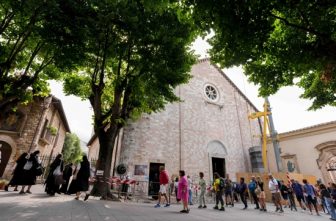I’ve been very fortunate in my young priestly life to witness many Catholic weddings. They are celebrations of great beauty, hope and joy, liturgies that remind all attendees of the power of Christian love and the great dignity of the sacrament of marriage.
Earlier this year, a few changes were made to the Catholic wedding liturgy, changes that may not be noticed by those who don’t attend weddings more than once every couple of years, but which are nevertheless important.
But before describing some of the actual changes themselves, some context is in order. As readers will remember, a new edition of the Roman Missal was released in the United States in 2011. The reason for the new missal was largely due to some new principles of liturgical translation that the Church had implemented in 2001.
Latin remains the official language of the Latin Rite Church, and all official liturgical texts are still released in Latin before any of the vernacular editions are released in the pertinent countries throughout the Catholic world. But whereas the official principle of translating Latin liturgical texts prior to 2001 was “dynamic equivalence” — that is, the conveyance of the basic idea of the original while still allowing for significant changes for the sake of clarity and meaning — the most current method of translation emphasizes the need for greater fidelity to the original Latin text and advocates for what might be called a more “literal” translation.
Because of these fundamental changes in principles, all outlined in a 2001 Vatican document “Liturgiam Authenicam,” all of the vernacular translations of official liturgical texts, such as the Roman Missal, the Rite of Baptism, the Book of Blessings, the Order of Christian Funerals, etc., had (or still have) to be re-translated. What is more, the actual Latin texts themselves are occasionally revised and re-released.
Up until this year, the English texts that U.S. Catholics had been using when celebrating marriages were all taken from an official translation that was produced only shortly after the first Latin edition of the post-conciliar Rite of Marriage was released — 1969. Since that time, a new Latin edition of the marriage liturgy was released in 1991, but no new official translation in English was ever released — until now.
In the new edition, an expanded introduction to the ritual describes the graces of marriage and encourages all those preparing couples for marriage to be actively involved in building up an entire parish culture that supports the vocation of marriage. It is a beautiful and helpful essay, and well worth the minister’s time as he prepares to witness the sacrament.
Another feature of the new ritual is the addition of a Glory to God at the start of the wedding Mass. This is a celebration! And the prescribed jubilant hymn of the Mass shows it.
Another new feature is the addition of a prayer by the minister immediately after the reception of the marriage vows, a blessing that concludes with an acclamation by the congregation. Similar to the memorial acclamation after the consecration at Mass (“The Mystery of Faith”), this new dialogue involves the community in the prayer of praise that is the celebration of any sacrament. Similarly, a congregational hymn or “canticle of praise” is now permitted immediately after the exchange of rings.
The new ritual also allows some very specific cultural adaptations, including the Latino tradition of blessing and giving of the arras (coins) and the use of the lasso. Both of these inclusions are specific to the U.S., and highlight the ever increasing and important presence of the Latino population within our Catholic community.
Finally, the new edition of the marriage ritual includes an appendix with various useful prayers, including the blessing of both a newly engaged couple and of a couple celebrating a significant wedding anniversary.
The words of the Catholic marriage liturgy are changing. But any time the words of the liturgy are altered, it provides us as worshiping believers with an opportunity to recommit ourselves to a better understanding of what it is that we do when we celebrate the sacraments: We give glory to God and participate in the salvation of the world — in good times and in bad, in sickness and in health.
Father Erickson is the director of the Office of Worship of the Archdiocese of St. Paul and Minneapolis and pastor of Blessed Sacrament in St. Paul.




